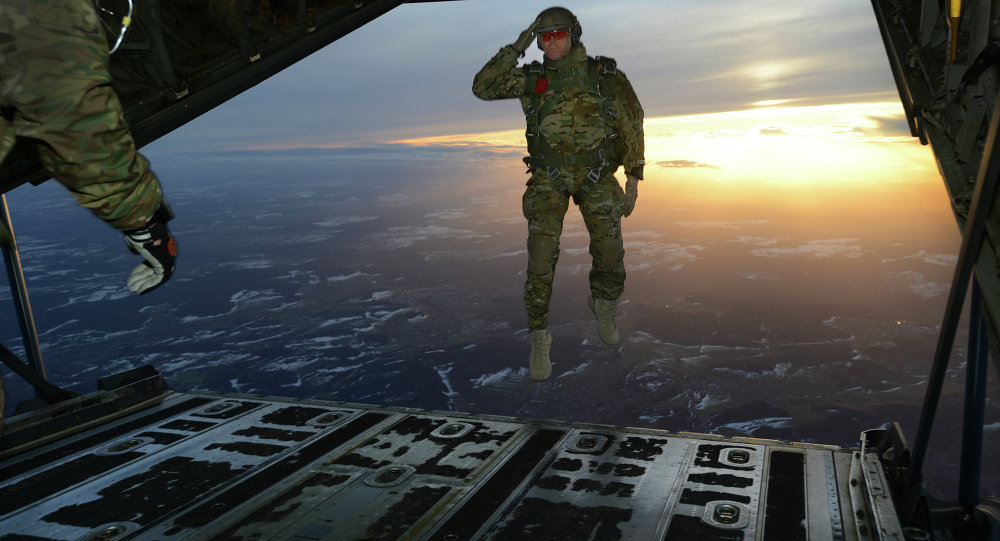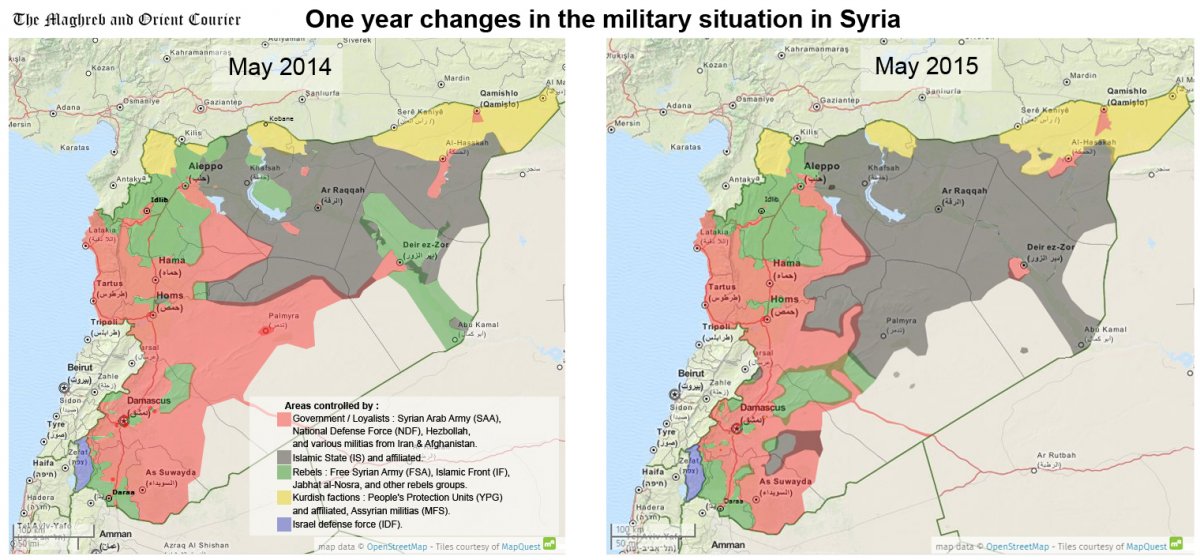
In the past several days, a number of announcements have been made by both the United States and Russia suggesting that we are now witnessing more than a mere placement of chess pieces on the board but the forward motion to some greater confrontation between two nuclear superpowers.
Throughout most of the Syrian crisis, the situation was one of semi-covert proxy war. However, with recent developments the situation is now more of semi-open conflict between the United States and Russia.
For instance, the potential for direct military conflict between the two superpowers became a much greater possibility earlier in the month when Russia "announced" that it was sending a number of Special Forces soldiers to Syria. The Wall Street Journal has since tried to represent these troops as having been transferred from Eastern Ukraine, a claim backed up by an anonymous "Russian official." However, while it is clear that Russia is indeed operating via Special Forces in Ukraine, the likelihood that a loyal "Russian official" would reveal such sensitive information to the U.S. media is highly suspect.
Regardless, it was reported by Chris Hughes of the UK Daily Mirror in early October that Russia's Spetsnaz unit were being moved to Syria in order to combat ISIS and other assorted "relatively moderate cannibals" and it is certainly within the realm of possibility and reasonable military strategy that Russian Special Forces have been deployed to Syria. Russia has officially denied the presence of Special Forces troops in Syria for the record.
The United States, however, is not even attempting to deny the presence of U.S. Special Forces troops in Syria and instead is advertising the plan publicly. Last week, President Barack Obama announced that the United States would be deploying 50 US Special Forces troops to Syria under the guise of "fighting ISIS" and engaging in "aid and assist" missions with forces fighting ISIS and ostensibly the Syrian government.
Of course, US Special Forces have long been active in Syria. From taking place in direct combat support missions for terrorist actors to logistical organization and spotting maneuvers, Special Forces have been having a cogent effect on the ability of terrorist forces to mount militarily sound attacks on government held positions for some time.
According to Sputnik, these Special Forces are not only operating far afield in the East where ISIS and "relatively moderate cannibals" have a tight grip on territory, they are operating in the West, where the Syrian government is the dominant force and where the Russian military is assisting in the mop up of terrorists most heavily. Sputnik reports,
US military advisors are alleged to have started training so-called moderate rebels near the city of Salma in the Latakia province in what amounts to breaking a pledge not to put US boots on the ground in Syria, Lebanon's satellite television channel al-Mayadeen reported, citing an unnamed military source.If the reports, attributed to an "unnamed Lebanese source," are to be believed, then US Special Forces are right in the middle of some of the heaviest fighting between Syrian government/Russian military/PDF and Western-backed terrorists.
On November 4, Reuters reported that Russian military personnel stationed in Syria now numbers around 4,000.
All of this taken together suggests that there is a very real possibility that the United States and Russia will soon see an escalation from semi-covert proxy war via terrorists and Syrian government forces (though one can hardly call Assad's forces proxies for Russia) to open conflict between U.S. and Russian Special Forces on the ground.
The question then becomes "what will happen if Russian Special Forces engage in combat against terrorists supported by and embedded with U.S. Special Forces?" How far will this conflict escalate? Will the Americans respond? Will the Russians and the Americans being firing on one another?
Indeed, if the United States commits itself to stay the course until the conflict is brought to an end, a confrontation between the two forces is almost inevitable since the Russian goal is to secure the territory currently held by the Assad government before moving East.
And then there is the air component.
The Air Component
While the United States has been bombing Syrian civilian infrastructure and, apparently, empty spaces and desert sand, the Russians have launched a brilliant move of bombing actually aimed at terrorists on the ground. The results are stunning. Only a few weeks of Russian airstrikes have revealed that, when an air force actually bombs ISIS, ISIS can be defeated. So far, the parallel bombing campaigns have taken place without a clash between Russian and American pilots. However, many have been wondering since the start of the Russian bombing just how long this period of conflict avoidance will continue?
After all, if the Russians continue to bomb terrorists in Syria and the Americans continue to bomb in support of them, particularly in terms of setting up a "No-Fly Zone," then a clash is virtually inevitable. That is, unless someone gives way and backs down. The Russians are not likely to do so because, in addition to the moral high ground on this issue, Russia is acting in strategic self-defense. To back down now would mean to ensure an even more aggressive attack on Russian interests and Russia itself in the very near future.
The United States, despite being the aggressor and in clear violation of international law as well as having the most leeway in terms of being able to back down respectably, is aware that if it does so its terrorist proxies will be wiped off the Syrian map and its onslaught against the Syrian government, Syrian people, and Russia will have been routed. Of course, this assumes that the United States truly wants to avoid a direct military confrontation with Russia to begin with, an idea that is not necessarily guaranteed.
Signs that the U.S. and Russia may soon be fighting one another over the skies of Syria recently appeared with the announcement that the United States will be deploying around a dozen fighter jets designed specifically for air-to-air combat - essentially dogfights - to Syria. Since ISIS has no air force, one can only assume that the jets are there to combat other fighter jets belonging to Assad and Russia. As The Daily Beast reports,
The U.S. Air Force is deploying to Turkey up to a dozen jet fighters specializing in air-to-air combat—apparently to help protect other U.S. and allied jets from Russia's own warplanes flying over Syria.In other words, the planes will be used to fight planes that are actually fighting ISIS. Even the notoriously deceptive Daily Beast was forced to report on the fact that these planes are indeed being deployed for the purpose of staving off Russian fighter jets. It reports,
Officially, the deployment of F-15C Eagle twin-engine fighters to Incirlik, Turkey—which the Pentagon announced late last week—is meant to "ensure the safety" of America's NATO allies, Laura Seal, a Defense Department spokesperson, told The Daily Beast.
That could mean that the single-seat F-15s and the eight air-to-air missiles they routinely carry will help the Turkish air force patrol Turkey's border with Syria, intercepting Syrian planes and helicopters that periodically stray into Turkish territory.
But more likely, the F-15s will be escorting attack planes and bombers as they strike ISIS militants in close proximity to Syrian regime forces and the Russian warplanes that, since early October, have bombed ISIS and U.S.-backed rebels fighting the Syrian troops. [emphasis added]
Seal declined to discuss the deployment in detail, but hinted at its true purpose. "I didn't say it wasn't about Russia," she said.It should be noted that, of the two parties, only the Russians are acting legally since Russia was invited in to Syria by the Syrian government while the United States is acting in violation of national sovereignty and international law as an aggressor.
Russia's air wing in western Syria is notable for including several Su-30 fighters that are primarily air-to-air fighters. The Su-30s' arrival in Syria raised eyebrows, as Moscow insists its forces are only fighting ISIS, but ISIS has no aircraft of its own for the Su-30s to engage.
The F-15s the U.S. Air Force is sending to Turkey will be the first American warplanes in the region that are strictly aerial fighters. The other fighters, attack planes and bombers the Pentagon has deployed—including F-22s, F-16s, A-10s and B-1s—carry bombs and air-to-ground missiles and have focused on striking militants on the ground.
In stark contrast, the F-15s only carry air-to-air weaponry, and their pilots train exclusively for shooting down enemy warplanes. It's worth noting that F-15Cs have never deployed to Afghanistan, nor did they participate in the U.S.-led occupation of Iraq. The war in Syria is different. [emphasis added]
Regardless, the recent U.S. escalation has now placed the world in a precarious position where two nuclear powers are acting in such close proximity to one another militarily that one trigger happy pilot or even one trigger happy soldier could now plunge the globe into a nuclear holocaust.
It is precisely this that the American people must begin to mobilize against before it is too late for us all.
Brandon Turbeville - article archive here - is an author out of Florence, South Carolina. He has a Bachelor's Degree from Francis Marion University and is the author of six books, Codex Alimentarius — The End of Health Freedom, 7 Real Conspiracies, Five Sense Solutions and Dispatches From a Dissident, volume 1 and volume 2, The Road to Damascus: The Anglo-American Assault on Syria, and The Difference it Makes: 36 Reasons Why Hillary Clinton Should Never Be President. Turbeville has published over 500 articles dealing on a wide variety of subjects including health, economics, government corruption, and civil liberties. Brandon Turbeville's podcast Truth on The Tracks can be found every Monday night 9 pm EST at UCYTV. He is available for radio and TV interviews. Please contact activistpost (at) gmail.com.







Russia has limited strike capabilities in the sense that Putin can't use his entire and China's military to wipe them all out , although he could. That's what they expect from him to get carried away, bored, frustrated with the whole situation and act move aggressively into the whole area and use that as an excuse to nuke Moscow. He's not going to do it, he's been very careful so far and he will continue to be. They tried to set him up in Ukraine and failed. Syria is Ukraine #2 , he's got even more experience now so the odds are in his favor.